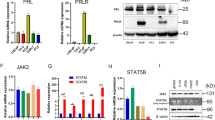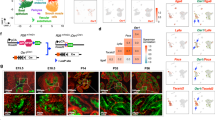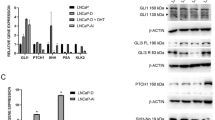Abstract
5α-Androstane-3α,17β-diol (3α-diol) is considered to have no androgenic effects in androgen target organs unless it is oxidized to 5α-dihydrotestosterone (5α-DHT). We used microarray and bioinformatics to identify and compare 3α-diol and 5α-DHT responsive gene in human prostate LNCaP cells. Through a procedure called ‘hypervariable determination’, a similar set of 30 responsive genes involving signal transduction, transcription regulation, and cell proliferation were selected in 5α-DHT-, 3α-diol-, and epidermal growth factor (EGF)-treated samples. F-means cluster and networking procedures showed that the responsive pattern of these genes was more closely related between 3α-diol and EGF than between 5α-DHT and 3α-diol treatments. We conclude that 3α-diol is capable of stimulating prostate cell proliferation by eliciting EGF-like pathway in conjunction with androgen receptor pathway.
This is a preview of subscription content, access via your institution
Access options
Subscribe to this journal
Receive 4 print issues and online access
$259.00 per year
only $64.75 per issue
Buy this article
- Purchase on Springer Link
- Instant access to full article PDF
Prices may be subject to local taxes which are calculated during checkout






Similar content being viewed by others
References
Keenan BS et al. Cytosol androgen receptor (AR) in human skin fibroblasts: characterization of the binding reaction and differentiation from androgen binding molecules of lower affinity. Steroids 1984; 43: 159–178.
Page MJ, Parker MG . Androgen-regulated expression of a cloned rat prostatic c3 gene transfected into mouse mammary tumor cells. Cell 1983; 32: 495–502.
Nelson PS et al. The program of androgen-responsive genes in neoplastic prostate epithelium. Proc Natl Acad Sci USA 2002; 99: 11890–11895.
Davies P, Eaton CL . Regulation of prostate growth. J Endocrinol 1991; 131: 5–17.
Bartsch W et al. Enzymes of androgen formation and degradation in the human prostate. Ann NY Acad Sci 1990; 595: 66.
Span PN et al. 3α-Hydroxysteroid oxidoreductase activities in dihydrotestosterone degradation and back-formation in rat prostate and epididymis. J Steroid Biochem Mol Biol 1996; 58: 319–324.
Penning TM . Moledular endocrinology of hydroxysteroid dehydrogenases. Endocr Rev 1997; 18: 281–305.
Jacobi GH, Moore RJ, Wilson JD . Studies on the mechanism of 3α-androstanediol-induced growth of the dog prostate. Endocrinology 1978; 102: 1748–1755.
Biswas MG, Russell DW . Expression cloning and characterization of oxidative 17β- and 3α-hydroxysteroid dehydrogenases from rat and human prostate. J Biol Chem 1997; 272: 15959–15966.
Huang XF, Luu-The V . Characterization of the oxidative 3α-hydroxysteroid dehydrogenase activity of human recombinant 11-cis-retinol dehydrogenase. Biochem Biophys Acta 2001; 1547: 351–358.
He XY et al. Function of human brain short chain L-3-hydroxyacyl coenzyme A dehydrogenase in androgen metabolism. Biochem Biophys Acta 2000; 1484: 267–277.
Leihy MW et al. Virilization of the urogenital sinus of the tammar wallaby is not unique to 5α-androstane-3α,17β-diol. Mol Cell Endocrinol 2001; 181: 111–115.
Ding VD et al. Sex hormone-binding globulin mediates prostate androgen receptor action via a novel signaling pathway. Endocrinology 1998; 139: 213–218.
Jacobi GH, Wilson JD . 3α-Androstanediol and prostatic growth: comparison of 3α-androstanediol formation in prostates from 8 species including man and dog. J Urol 1979; 121: 612–614.
Walsh PC, Wilson JD . The induction of prostatic hypertrophy in the dog with androstanediol. J Clin Invest 1976; 57: 1093–1097.
Schultz FM, Wilson JD . Virilization of the Wolffian duct in the rat fetus by various androgens. Endocrinology 1974; 94: 979–986.
Shaw G et al. Prostate formation in a marsupial is mediated by the testicular androgen 5α-androstane-3α,17β-diol. Proc Natl Acad Sci USA 2000; 97: 12256–12259.
Nunlist EH et al. Partitioning of 5α-dihydrotestosterone and 5α-androstane-3α, 17β-diol activated pathways for stimulating human prostate cancer LNCaP cell proliferation. J Steroid Biochem Mol Biol 2004; 91: 157–170.
De Bellis A et al. Epidermal growth factor, epidermal growth factor receptor, and transforming growth factor-alpha in human hyperplastic prostate tissue: expression and cellular localization. J Clin Endocrinol Metab 1996; 81: 4148–4154.
De Miguel P et al. Immunohistochemical comparative analysis of transforming growth factor alpha, epidermal growth factor, and epidermal growth factor receptor in normal, hyperplastic and neoplastic human prostates. Cytokine 1999; 11: 722–727.
McKeehan WL, Adams PS, Rosser MP . Direct mitogenic effects of insulin, epidermal growth factor, glucocorticoid, cholera toxin, unknown pituitary factors and possibly prolactin, but not androgen, on normal rat prostate epithelial cells in serum-free, primary cell culture. Cancer Res 1984; 44: 1998–2010.
MacDonald A, Habib FK . Divergent responses to epidermal growth factor in hormone sensitive and insensitive human prostate cancer cell lines. Br J Cancer 1992; 65: 177–182.
Culig Z et al. Activation of the androgen receptor by polypeptide growth factors and cellular regulators. World J Urol 1995; 13: 285–289.
Dozmorov I, Centola M . An associative analysis of gene expression array data. Bioinformatics 2003; 19: 204–211.
Jarvis JN et al. Novel approaches to gene expression analysis of active polyarticular juvenile rheumatoid arthritis. Arthritis Res Ther 2003; 6: R15–R32.
Dozmorov I et al. Connective molecular pathways of experimental bladder inflammation. Physiol Genomics 2003; 15: 209–222.
Dozmorov I et al. Neurokinin 1 receptors and neprilysin modulation of mouse bladder gene regulation. Physiol Genomics 2003; 12: 239–250.
Toh H, Horimoto K . Inference of a genetic network by a combined approach of cluster analysis and graphical Gaussian modeling. Bioinformatics 2002; 18: 287–297.
Härle P et al. Differential effect of murine alpha/beta interferon transgenes on antagonization of herpes simplex virus type 1 replication. J Virol 2002; 76: 6558–6567.
Knee DA et al. Structure–function analysis of Bag1 proteins. Effects on androgen receptor transcriptional activity. J Biol Chem 2001; 279: 12718–12724.
Briknarova K et al. Structural analysis of BAG1 cochaperone and its interactions with Hsc70 heat shock protein. Nat Struct Biol 2001; 8: 349–352.
Xiao N, DeFranco DB . Overexpression of unliganded steroid receptors activates endogenous heat shock factor. Mol Endocrinol 1997; 11: 1365–1374.
Bailey CK et al. Molecular chaperones enhance the degradation of expanded polyglutamine repeat androgen receptor in a cellular model of spinal and bulbar muscular atrophy. Hum Mol Genet 2002; 11: 515–523.
LeClerc S et al. Molecular cloning and characterization of a factor that binds the human glucocorticoid receptor gene and represses its expression. J Biol Chem 1991; 266: 17333–17340.
Campbell DH, Sutherland RL, Daly RJ . Signaling pathways and structural domains required for phosphorylation of EMS1/cortactin. Cancer Res 1999; 59: 5376–5385.
Thomas CY et al. Spontaneous activation and signaling by overexpressed epidermal growth factor receptors in glioblastoma cells. Int J Cancer 2003; 104: 19–27.
Sun M et al. Activation of phosphatidylinositol 3-kinase/Akt pathway by androgen through interaction of p85α, androgen receptor, and Src. J Biol Chem 2003; 278: 42992–43000.
Chen T, Wang LH, Farrar WL . Interleukin 6 activates androgen receptor-mediated gene expression through a signal transducer and activator of transcription 3-dependent pathway in LNCaP prostate cancer cells. Cancer Res 2000; 60: 2132–2135.
Yang L et al. Interleukin-6 differentially regulates androgen receptor transactivation via PI3K-Akt, STAT3, and MAPK, three distinct signal pathways in prostate cancer cells. Biochem Biophys Res Commun 2003; 305: 462–469.
Mahendroo MS, Cala KM, Russell DW . 5 α-reduced androgens play a key role in murine parturition. Mol Endocrinol 1996; 10: 380–392.
Rizner TL et al. Human type 3 3α-hydroxysteroid dehydrogenase (aldo-keto reductase 1C2) and androgen metabolism in prostate cells. Endocrinology 2003; 144: 2922–2932.
Lin H-K et al. Expression and characterization of recombinant type 2 3α-hydroxysteroid dehydrogenase (HSD) from human prostate: demonstration of bifunctional 3α/17β-HSD activity and cellular distribution. Mol Endocrinol 1997; 11: 1971–1984.
Torn S et al. Production, purification, and functional analysis of recombinant human and mouse 17β-hydroxysteroid dehydrogenase type 7. Biochem Biophys Res Commun 2003; 305: 37–45.
Connolly JM, Rose DP . Production of epidermal growth factor and transforming growth factor-α by the androgen-responsive LNCaP human prostate cancer cell line. Prostate 1990; 16: 209–218.
Sehgal I et al. Epidermal growth factor receptor-dependent stimulation of amphiregulin expression in androgen-stimulated human prostate cancer cells. Mol Biol Cell 1994; 5: 339–347.
Schuurmans AL et al. Regulation of growth and epidermal growth factor receptor levels of LNCaP prostate tumor cells by different steroids. Int J Cancer 1988; 42: 917–922.
Sherwood ER et al. Epidermal growth factor receptor activation in androgen-independent but not androgen-stimulated growth of human prostatic carcinoma cells. Br J Cancer 1998; 77: 855–861.
Kondapaka BS, Reddy KB . Tyrosine kinase inhibitor as a novel signal transduction and antiproliferative agent: prostate cancer. Mol Cell Endocrinol 1996; 117: 53–58.
Stoner E . The clinical development of a 5α-reductase inhibitor, finasteride. J Steroid Biochem Mol Biol 1990; 37: 375–378.
Iversen P et al. Bicalutamide monotherapy compared with castration in patients with nonmetastatic locally advanced prostate cancer: 6.3 years of followup. J Urol 2000; 164: 1579–1582.
See WA et al. Bicalutamide as immediate therapy either alone or as adjuvant to standard care of patients with localized or locally advanced prostate cancer: first analysis of the early prostate cancer program. J Urol 2002; 168: 429–435.
de Vere White R et al. Human androgen receptor expression in prostate cancer following androgen ablation. Eur Urol 1997; 31: 1–6.
van der Kwast TH, Tetu B . Androgen receptors in untreated and treated prostatic intraepithelial neoplasia. Eur Urol 1996; 30: 265–268.
El Sheikh SS et al. Androgen-independent prostate cancer: potential role of androgen and ErbB receptor signal transduction crosstalk. Neoplasia 2003; 5: 99–109.
Orio F et al. Potential action of IGF-1 and EGF on androgen receptor nuclear transfer and transactivation in normal and cancer human prostate cell lines. Mol Cell Endocrinol 2002; 198: 105–114.
Jones HE et al. Effect of an EGF-R selective tyrosine kinase inhibitor and an anti-androgen on LNCaP cells: identification of divergent growth regulatory pathways. Prostate 2001; 49: 38–47.
Acknowledgements
This work was supported by the NIH Grant DK54925 to HKL.
Author information
Authors and Affiliations
Corresponding author
Rights and permissions
About this article
Cite this article
Zimmerman, R., Dozmorov, I., Nunlist, E. et al. 5α-Androstane-3α,17β-diol activates pathway that resembles the epidermal growth factor responsive pathways in stimulating human prostate cancer LNCaP cell proliferation. Prostate Cancer Prostatic Dis 7, 364–374 (2004). https://doi.org/10.1038/sj.pcan.4500761
Received:
Revised:
Accepted:
Published:
Issue Date:
DOI: https://doi.org/10.1038/sj.pcan.4500761



